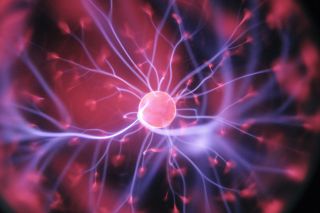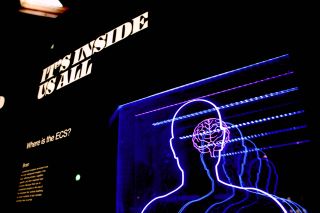Neuroscience
How Hans Berger's Irrationality Changed Psychology Forever
The unexpected origin story of EEG.
Posted March 12, 2023 Reviewed by Jessica Schrader
Key points
- Hans Berger originally fancied himself an astronomer, but a spooky near-death experience put him on another path.
- He became obsessed with discovering the basis of telepathy and was convinced that the brain emitted invisible energy.
- While wrong about the "science" of telepathy, his work ultimately led to EEG—an incredibly powerful tool for studying human psychology.
Strange, inexplicable feelings often accompany life-and-death situations. Face to face with one’s own mortality, people often feel as though time slows down, or that their life flashes before their eyes. Others report feeling extreme clarity and resolution.
On one particular occassion, a strange set of feelings, arising from the grips of mortal danger, changed the field of neuroscience forever. This is how electroencephalography (EEG) was born.
In 1892, Hans Berger, a mathematics student at the University of Jena in Germany, enrolled for a year in the cavalry. During a military exercise, he was suddenly thrown off his horse right into the path of a horse-drawn cannon. Lying helplessly on the ground, he stared up at the heavy artillery in sheer terror, inches away from crushing him.

At that moment, miles away, his sister had a sudden premonition that something was terribly wrong. The feeling was so intense that she insisted that her father telegram him immediately.
Back on the training ground, the quick reflexes of the artillery driver saved Berger's life. He escaped the incident with only a few bruises and quickly recovered. However, his sister's sudden intuition stayed with him long after the event. He could not dismiss the incident as mere coincidence and was convinced there must be a hidden science to uncover. He quickly became engulfed with the concept of telepathy, and it became the sole focus of his scientific career.
Originally a mathematics student, Berger wanted to be an astronomer. But after the incident, he returned to Jena and switched to medicine and physiology. He worked tirelessly to uncover the science behind these mysterious telepathic forces, an obsession that took him directly to the cutting edge of neuroscience.
Hans Berger's Journey Into Psychology and Neuroscience
It's hard to imagine a more forlorn pursuit than trying to uncover the "science" of telepathy. A century later, the evidence is clear that no such ability exists. There’s ample confidence in this assertion since it’s a simple question to test: If telepathy is possible, people should be able to reliably communicate across large distances with the simple power of their minds.

Countless experiments have put that idea to the test with variations of the following setup: Give person A a number between 1 and 100, and instruct them to try and telepathically communicate that number to person B the next room over. The findings are consistent. Even if both participants are ardent believers, their guesses are still no greater than chance.
For Berger, however, his investigations lead to a scientific breakthrough. He wasn't interested in telepathy per se, and he never tried to replicate his sister's experience. Instead, he simply assumed that the phenomenon existed and wanted to deeper into the mechanisms that allow it to transpire. As he described, his dedication was to "the search for the correlation between objective activity in the brain and subjective psychic phenomena." He was convinced that there must be a hidden force emitted from the brain.
And on this specific point, he was right.
After decades of toil, in 1924, Berger provided the first-ever recording from electroencephalography (EEG). EEG measures the electrical activity that emits from the scalp, which is a proxy for the underlying neural activity, and which is, in turn, a proxy for a person's mental activity.
His goal was to find the connection between "physical brain activity" and "subjective psychic phenomena," and this was an absolute bullseye. EEG displays that connection in the most direct way possible.
The invention of EEG was nothing short of a neuroscientific breakthrough. By the 1930s, medical practitioners all over the U.S. and Europe employed EEG for medical diagnoses, especially for epilepsy and sleep disorders.
EEG also revolutionized the budding science of the brain. It provided an unprecedented window into human nature not otherwise possible.
Applications of EEG for Studying Neuroscience
Before EEG, learning about the brain was a relatively crude affair. The bulk of data came from neuropsychology—a sub-field dedicated to studying patients who have suffered a brain injury. The basic idea is to treat neural disassociations as a window into the brain's specialization: The brain is healthy and capable of the full range of functions. Then there was damage to region A, and now the person can't do function X. Therefore, region A must somehow be involved in producing function X.

This is not to say that neuropsychology didn't contribute to the field. For example, the neuropsychologist Paul Broca made considerable contributions to the neuroscience of language. Much of this came from studying a patient who had lost the ability to speak despite still being very intelligent and fully lucid. He became known as "Patient Tam," as that was the only syllable he could muster when trying to communicate. When he died, his autopsy revealed a large lesion in the left frontal lobe, now called "Broca's Area," and is understood today as being the critical region for language production.
Much of the foundational understanding about the neural basis of functions like memory, decision-making, and perception all came from studying patients. But it was a slow, grueling process. Moreover, because the object of study is predicated on naturally occurring injuries, your insights were limited to whatever poor fortune befell your patients. These injuries are also not always neat and tidy, making it difficult to understand what specific damage produced what specific deficit.
To study the brain was to wait around for something unfortunate to happen to someone's brain. And then hoping these poor souls found their way to your lab so you could study their unique deficits. EEG changed all of that.
This is part 1 of a 2-part series on the origin of EEG. The second piece, on the specific implications and applications of EEG can be found here.
This post also appeared on the human nature blog, NeuroScience Of
References
Broca, P (1861). “Remarks on the Seat of the Faculty of Articulated Language, Following an Observation of Aphemia (Loss of Speech)” Archived 17 January 2001 at the Wayback Machine. Bulletin de la Société Anatomique, Vol. 6, (1861), 330–357
Berger, H. (1940), Psyche, 6
Millet D. (2002), "The Origins of EEG" International Society for the History of the Neurosciences (ISHN)
Tudor, M.; Tudor, L.; Tudor, K. I. (2005). "Hans Berger (1873-1941)--the history of electroencephalography". Acta Medica Croatica : Casopis Hravatske Akademije Medicinskih Znanosti. 59 (4): 307–13. PMID 16334737.




